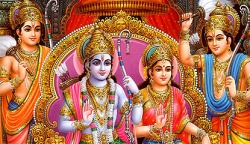Temples
HISTORY OF TEMPLE
About Bhadrachalam
Bhadrachalam is located in Khammam District, Andhra Pradesh at a distance of over 300 km slightly northeast of Hyderabad. A famous pilgrimage shrine, the abode of Lord Rama, situated at the bank of holy river Godavari, and also the home of ITC PSPD which is one of the premier paper manufacturers in the world, while retaining the charm of a rural Indian town. Combining high technology and modern facilities with stable employment, and retaining the religious and holy nature of the age-old practices makes Bhadrachalam a great place to visit. Today devotes of Lord Rama can still be a part of the services performed from the time of the construction of the temple, and visit the beautiful surroundings of Bhadrachalam. Also, not forgetting the modern infrastructure built by ITC and the modern techniques and life of the people who work for the paper manufacturer.
History of Bhadrachalam
Kancharla Gopanna popularly known as Bhakta Ramadas in the year 1630 AD constructed Bhadrachalarama temple. He was born to Linganna Murthy and Kamamba in Nelakondapalli village of Khammamett Taluk in 17th century (1630 AD). As Tasildar he was discharging his official duties earnestly and collecting revenues due to Nawabs in continuation of daily preaches - Chanting of 'Ramanama' and the feeding the poor at his house. Ramadasa who heard the news that the villagers of palvoncha paragana were proceeding to witness Jatara at Bhadrachalam, He too out of curiosity visited Bhadrachalam. He found the deities in an amazing appearance; Ramadas then asked the villagers to contribute liberally for the construction of the temple .The villagers in response appealed him to spend the revenue collections for the construction of the temple with a promise to repay the amount after harvesting the crops. As such Ramadas constructed the temple with an amount of Rs 6 Lakhs collected from the land revenues with out the permission of the Nizam Nawab.
When the temple reached completion, he had a problem of fixing the 'Sudarshana Chakra' at the crest of the main temple. Deeply distressed he fell into sleep. On the same night, Rama in his dream asked him to have a holy dip in the river Godavari where he would find it - accordingly. On the next day morning Gopanna did so and found holy Sudarshana Chakra in the river with out much difficulty. He presumed that Sudarshana Chakra itself was shaped up with the divine power of his beloved God Rama. Soon after the construction, his miseries started. He was dismissed from service for mis-utilisation of revenue for constructing the temple and was kept in jail for 12 long years in Golconda Fort and was tortured. Unable to withstand the miseries, Ramadas implored Rama to relieve him by singing many praising and emotional songs, which got popularized from the stanzas of 'Dasaradhi Sathakam ' and 'Keertanas' of Bhakta Ramadasa.
The Nizam Nawab Tanishah, the then ruler of Nizam's territory became a devotee of Rama who realized the devotion spirit of Ramadas after his imprisonment and took over the charge of temple administration. This resembles the communal harmony amongst the Hindus and Muslims. The Nizam Nawab, Tanishah realized Ramadas's devotional spirit and dedication towards Rama, when Rama and Laxmana repaid 6 lakhs Mohurs exposing themselves as Ramoji and Laxmoji, the servants of Bhakta Ramadas to get release of their devotee from the imprisonment. Thanisha gave voucher to these divine looking persons who approached him at his house during late night. Then they kept the voucher under the pillow of Gopanna where he was jailed. Tanishah who woke up on the very next day morning realized that those divine looking persons were none other than Rama and Laxmana and made arrangements to get release of Gopanna and prayed to forgive him by placing all the Gold Mohurs received last night at the feet of Gopanna. But, he refused to take back those mohurs except two as a mark of divine significance, and these two coins can still be seen in Bhadrachalam Temple.
Influenced by the majesty of Lord Rama, Golconda Ruler Tanishah earmarked the income derived from the said Palwoncha paragana which came to Rs 20,000 and odd for the maintenance of the temple which was continued during Nizam's reign and offering Pearls on the occasion of kalyana mahotsavam (Sri Rama Navami) to Deities on an elephant through a specially sent messenger. That procedure of sending pearls to the Deities is still followed by present state Government and continued to offer during Sri Rama Navami Festival. Tumu Narsimha Dasa, Tahasildar of Palwoncha paragana, along with his associate Varada Ramadasa came here from Guntur and took over charge of Bhadrachalarama temple after Ramadas made inscribed the performance of Nitya Poojas and sevas right from early morning "Suprabhata Seva" till night "Pavalimpu Seva" before closure of the temple as "Silaasaasanaalu" on these two pillars. This inscription gave details of daily dittam and daily rituals also. People Who Worked in Bhadrachalam Dr.A.P.Ranga Rao worked as Medical Officer in Govt.Civil and ID Hospitals from 1974 till 1978. Sri.Hari Narayana Jandhyala IAS Present Cheif Secretry Govt.Of Andhra Pradesh Worked here as Sub Collector Sri.Jainder Singh IAS Presently Secretry Information Technology Govt.Of India Worked as Sub Collector Bhadrachalam. Sri.R.C.Samal IAS Presently Cheif Commissioner Vigilance Govt.Of Andhra Pradesh worked As Sub Collector Bhadrachalam. Dr.Bharath who is a dental Surgeon in Hyderabad lived here From 1974 to 1978.

